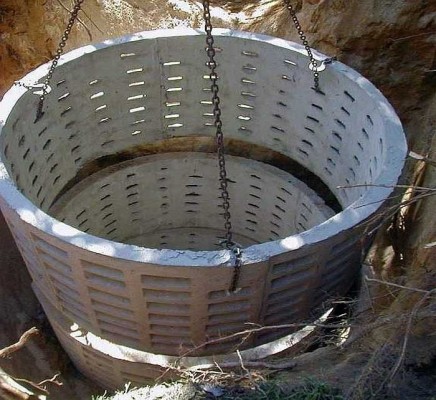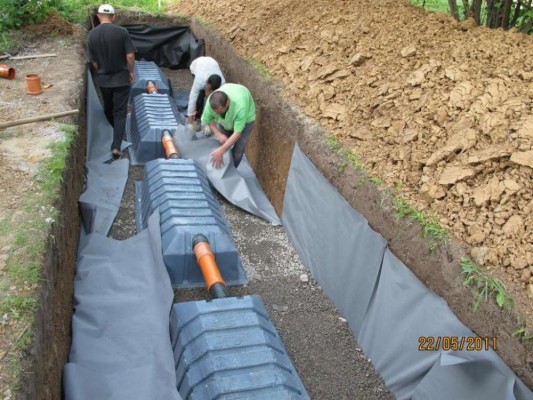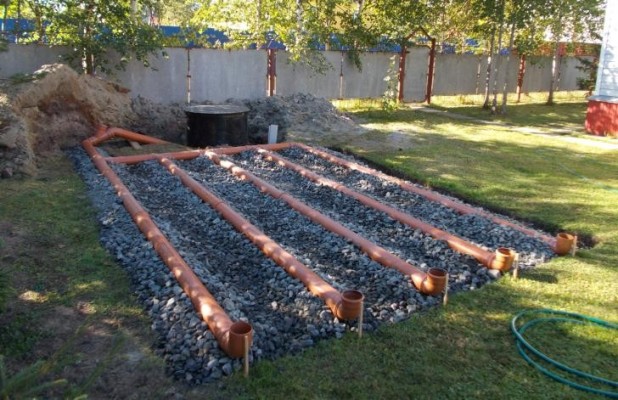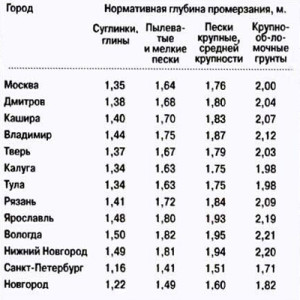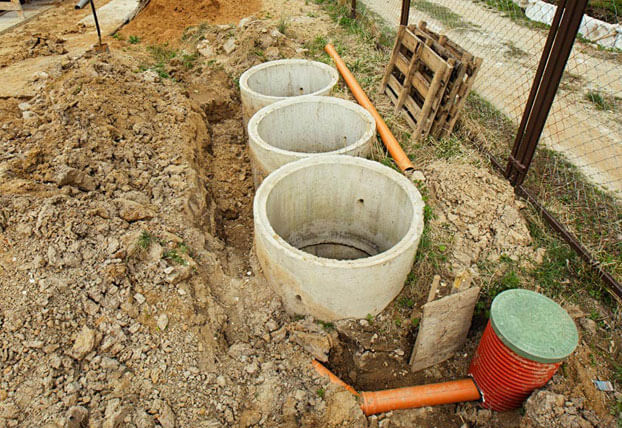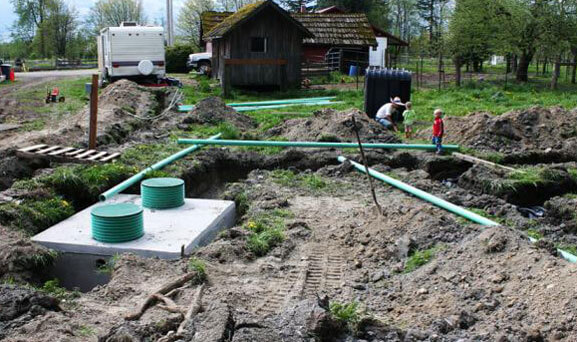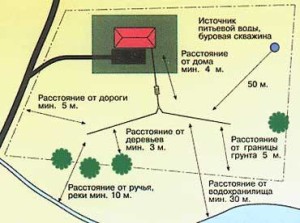Types of septic tanks for a country house
Previously, when the production of plastic septic tanks was not so massive, reinforced concrete structures were more popular, which were assembled in stages. Metal cleaning systems were also used. Today, wastewater treatment most often occurs with the help of ready-made plastic installations. These products are reliable and durable. A high level of sealing ensures the environmental safety of the installations. Depending on the performance characteristics, they are classified according to different criteria.
-
-
The classic storage option is an analogue of a conventional settling pit into which wastewater flows.
In such tanks, water is stored until it is pumped out by a sewage machine. Storage plants require regular cleaning. Although the cost of such containers is small, but the frequent call of machines for cleaning is an expensive “pleasure”. Therefore, such a choice can hardly be called economical.
-
With soil cleaning - this option defends and cleans drains through a special drainage field.
Water is thrown out, and sediment remains in the tank itself, which must be removed 2-3 times a year using special equipment. As a result of treatment in such a septic tank, the water becomes 60-85% purer. Energy independence and ease of operation are the advantages of such a structure. But it cannot be installed in areas with high aquifers due to poor cleaning through soil filters.
-
Septic tank with deep biological treatment - in this case, you can achieve a high level of wastewater treatment (98-99%) and even reuse the liquid for household needs or for watering the garden.
In this option, all types of wastewater treatment are used: chemical, biological, mechanical. Such tanks can be installed in any type of soil, they do not rot and can serve for several decades. The disadvantages of biological septic tanks include their energy dependence. Therefore, in areas where power is often turned off, it will be difficult to achieve the normal functioning of the installation.
-
-
-
From reinforced concrete - this option can be chosen for houses where they live off-season, that is, all year round. They serve for a long time, but need good waterproofing and are quite difficult to install.
-
Plastic containers can be installed in areas where the groundwater level is high. Plastic septic tanks for a private house are not subject to corrosion and are not afraid of the influence of aggressive environments.
-
Metal tanks are made of stainless steel. However, compared to plastic and concrete counterparts, they are not so durable and practical. In addition, such septic tanks are quite expensive.
-
-
-
A horizontal septic tank is most often chosen for areas where water from the ground rises high in the autumn-spring period.
The horizontal container has the form of a cylinder and is made of plastic or stainless steel. Suitable for installing a country house with a large amount of wastewater (10 or more cubic meters).
-
A vertical septic tank is buried deeper than a horizontal tank.
Such products are suitable for installation in a sewerage system with a small amount of wastewater (up to 2 cubic meters). However, such a tank is more airtight than the horizontal version.
-
Sometimes a combined version of horizontal and vertical septic tanks is used, where each tank is responsible for certain wastewater from the bathroom, kitchen or toilet.
-
-
By location
-
Underground - a more common version of the design, which is buried to a certain depth. At the same time, the landscape of the site is not affected.
-
The ground version of the structure is used if the geology of the site does not allow the installation of an underground version due to the high level of groundwater.In this case, the septic tank will spoil the landscape of the site, so it should be mounted away from the viewing angle.
-
Distance from septic tank to fence
One of the important questions is: what should be the distance from the septic tank to the fence? There is no single answer. Formally - at least 1 m (some lawyers say that 2 m). This is where the most "interesting" begins. The indicated distance of 1 meter is a special case when there is nothing behind the fence or in front of it. from the wall. If there are bushes or trees along the fence on their site, then they are taken as the starting point. If there are no plantings at home, and there are plantings along the neighbor's fence, then again, measurements are made from them. The circumstances are even worse when two houses are separated. Here, from the closest point of the house to the beginning of the septic tank, there should be at least 8-12 meters. The same applies to everything else: a well, a well, outbuildings, etc. Therefore, measuring from the fence, in principle, does not make sense. Therefore, without the consent of the neighbors and the permission of the relevant authorities who know the laws and the availability of communications, you don’t even need to think about VOCs.
Post-treatment of wastewater in the ground
The location of the septic tank determines not only the type and design of the treatment device, but also the technologies used for soil post-treatment.
Absorption (filtering) well
The absorption well is the simplest and least space-consuming device for soil post-treatment. Drains are removed into the ground through the bottom and walls of the well, which is the last section of the septic tank or the outlet of the aeration biofilter. The absorbing part of the well (bottom and perforated walls) must necessarily be located above the groundwater level (GWL) and below the depth of soil freezing. If the GWL on the site is too high, the construction of an absorption well is impossible. We recommend to remove as much as possible the source of drinking water (well, well) from the absorber. And not only his own, but also his neighbor's.
Installation of a filtration well from perforated reinforced concrete rings. Absorption of runoff by soil will be carried out both through the bottom and through the walls
filter trench
The filter trench is a perforated horizontal pipe sprinkled with gravel. Clarified drains seep through the holes into the backfill, bacteria that process biological pollution live on the surface of the pebbles. The advantages of this solution: low cost, minimum excavation, the possibility of a filtration device at a high GWL. Minus: neither trees nor shrubs can be planted near the filter trench. When deepening a trench operated in winter above the level of soil freezing, it must be isolated from the surface with a layer of hydrophobic insulation. Expanded polystyrene, expanded clay is suitable.
The length of the trench is calculated based on the volume of drains and the presence of ventilation
An analogue of a filter trench with an increased volume of backfill and protected from atmospheric influences. If the infiltrator is provided with a ventilation outlet to the surface and thereby ensures air flow into the trench, the organics processing process can be intensified. The device can be located both below and above ground level, partially or fully. This solution is used at very high GWL in combination with an aeration tank with forced pumping of wastewater, when other systems are not suitable. The pipe and backfill are closed from above with a polymer “lid”, if necessary, insulated and covered with soil. An earthen mound overgrown with grass remains on the surface.
The infiltrator can be multi-section
In fact, the filtration field is a system of branched filtration trenches. Due to the long length of the pipes, the best wastewater treatment is achieved. Planting a garden over pipes is not allowed.By the way, magnificent lawns in front of private houses in America are broken just above the filtration fields, because 95% of houses in North American towns are equipped with local sewer systems. Filtration fields are inexpensive in warm climatic conditions, but arranging them in areas with a large depth of soil freezing is not so profitable, the amount of excavation is too large.
The filter field is a good thing, but it takes up a lot of space
What is fraught with the wrong location
soil freezing table
Since a septic tank is a reservoir where sewage accumulates and is cleaned, special requirements are placed on it. Before proceeding with the installation, you will have to complete the project and coordinate it with the SES. This will allow you to obtain permission to carry out installation work. However, only if the project fully complies with all standards for installing a septic tank in this area.
The main issue is the right site for the equipment. So, where on the site to place a septic tank? This is determined taking into account the current standards prescribed in:
They indicate the distances to water intakes, residential buildings and other objects. An important condition is compliance with the norms for the installation of a septic tank near a well with drinking water.
After all, it is very important that the waste does not get into the water. Otherwise, it will not only lead to pollution, but also pose a threat to human health.
There should be the maximum possible distance between the tank and the well. It is determined by the height of the layers between the aquifers and the soil used as a filter for treated effluents.
If there is no connection between them, then a gap of at least 20 m is allowed. This can be determined using hydrogeological studies. According to experts, light soils are considered the best natural filters. If you have such soil, then the gap between the septic tank in the summer cottage and the well should be more than 50 m.
SES rules for septic tanks, do I need permission
In order for the operation of the septic tank to be safe and uninterrupted, it must be located at a distance of more than five meters from neighboring areas. If this requirement is violated, such a phenomenon as sewage filtration into the soil of a neighboring site is possible.
Also, the septic tank should be located more than two meters from the road, as well as more than two meters from the border of the site and more than five meters from the doors and windows of the residential building. In addition, to ensure the sanitary and epidemiological safety of drinking water, an autonomous sewage system should be located more than fifteen meters from a well or well from which water enters the house.
To install an autonomous sewage system, you can use the services of professionals or try to install it yourself. In the case of independent work, it is necessary, first of all, to obtain permission to install a septic tank. To do this, you will need to collect a number of documents and certificates.
Permission to install a septic tank, necessary documents
The main documents that allow you to obtain a permit for a septic tank are:
- technical certificate;
- device diagram drawn up in the design organization;
- residential building project;
- ownership document;
- topological survey of the site;
- agreement on the removal of liquid household waste.
After all the necessary documents have been collected, the owner of the site must write an application asking for permission to install a septic tank. This can be done both in the environmental protection authorities and directly in the sanitary and epidemiological station itself. It is noteworthy that an application for a septic tank permit is accepted only if there is an attached list of all necessary documents.
Owners of individual plots need to remember that after the installation of a septic tank, SES has the right to carry out scheduled and unscheduled inspections of the quality of wastewater treatment.
Sanitary and epidemiological features of the installation of a septic tank
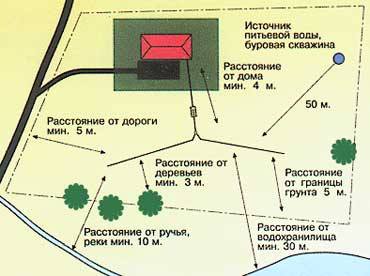
It should be noted that the sanitary norms and rules stipulate the possibility of discharging groundwater into water bodies. For this, the maximum permissible concentration of harmful substances in the treatment system must be less than in the reservoir itself. However, in practice it is impossible to achieve the concentration of harmful substances allowed for such a case by sanitary norms and rules.
Thus, obtaining permission for a septic tank from SES is an important step in installing an individual treatment system. A properly installed treatment plant is a guarantee of sanitary and epidemiological safety, both for the residents themselves and for the environment.
Design features of septic tanks
An ordinary cesspool is not a completely safe solution. The effluents that enter it are absorbed into the soil and can penetrate into the groundwater, and they feed the wells that are used to obtain drinking water. It turns out that drinking water can become toxic. Of course, with the correct location of the cesspool, you can reduce the likelihood of such a development of events, but still this solution has long been out of date. And why use the old-fashioned way, when a modern septic tank is not so expensive, but many times more reliable.
Septic tanks according to the principle of operation can be divided into the following types:
- storage tanks are an improved cesspool. A septic tank of this type is a sealed tank in which effluents simply accumulate, from time to time such a septic tank must be cleaned. The main advantage compared to a cesspool is that there is no contact of wastewater with the soil, and therefore the risk of contamination is minimized. Storage tanks are suitable for cottages where there is little wastewater;
- settlers allow not only to accumulate, but also to treat wastewater, which greatly simplifies the operation process. The septic tank consists of two or three chambers, in each of which a certain stage of cleaning is carried out. The first section is usually the most voluminous. It is designed for the accumulation of wastewater and their primary settling, sediment settles at the bottom, and more or less purified water flows into the second tank, where smaller particles go into the sediment. The third tank is a compartment with a biofilter, where the water is further purified, but it may be absent. Then comes the stage of soil filtration. The solid sediment is gradually compacted, and the bacteria contained in the drains partially process it, therefore it is infrequent to pump out the septic tank - about once a year. Settling tanks are relatively inexpensive, but for high-quality cleaning it is necessary to choose containers of sufficient volume, plus take care of the arrangement of soil filtration;
- a septic tank with deep biological treatment is already more complex equipment. At the first stage, the effluents are settled, and then they enter the section with an aerator. In the presence of air, aerobic bacteria process most of the sediment, then sedimentation occurs again, and the purified water can be removed from the septic tank, although it first passes through a gravel filter. Septic tanks of this type are compact, have a minimal presence of smell, do not require pumping, but are expensive. In addition, it will be necessary to connect electricity, and this is also a cost.
To ensure maximum tightness, it is better to take industrial-made septic tanks, but some craftsmen undertake to make such equipment with their own hands.So, depending on the material of manufacture of septic tanks are:
plastic - the best option in terms of tightness, price, corrosion resistance and weight. Ready-made septic tanks are sold in different sizes, they are designed to process different amounts of sewage.
Home-made septic tanks, which are made of bricks, concrete rings, tires and plastic containers, are able to clean drains by 60% and no more, while industrial septic tanks can cope with this task much more efficiently, cleaning sewage by 99%. But even the most expensive industrial septic tank is not a guarantee of complete comfort and safety. You need to know where to place the septic tank so that an unpleasant odor does not enter the house, and toxins from the drains do not enter the drinking water.
Septic tank options for the site
First of all, they are:
-
Monolithic
when the sewer tank fully meets the requirements of waterproofing and it does not need to be further treated from the inside with bitumen or cement mortar. -
teams
. Such systems will have to be subjected to a thorough waterproofing process, because there will be joints and gaps. As a rule, this kind of septic tank is not easy to install and it takes a lot of time.
And this could be:
- Brick,
- metal or plastic containers,
- Concrete or concrete rings
According to its principle of operation, septic tanks can be divided into the following types:
- Cumulative (their function is just the collection of wastewater).
- Treatment. They contain bioactivators that purify and filter incoming effluents. This is convenient because the resulting water can be reused. For example, for watering crops.
- With soil filtration system. Such septic tanks also perform the function of wastewater treatment and release the resulting water into the ground.
Depending on how deep your septic tank will be located, they are divided into:
Perhaps one more gradation can be distinguished:
-
Volatile
septic tanks requiring connection of their system to the mains. -
Autonomous
working without electricity. And this, in general, is convenient.
Cesspools and storage septic tanks
In private houses, in addition to septic tanks, simple cesspools without a bottom can be built. However, there are certain requirements that apply directly to them:
- They must be waterproof.
- Above the structure must be a cover or grate.
- The pit must be cleaned at least twice a year.
- In addition, regular disinfection with a mixture containing a number of cleaning elements is required. Dry bleach should not be used.
A few decades ago, such a type of sewer structure as a cesspool. seemed the only possible one. Today it is almost not used, but in some places it can still be found. The structure is a pit without a bottom. The material can be brick, cement, concrete rings or another type. The liquid from the drains, falling into the pit, freely seeps into the soil, at the same time being cleaned. All solid organic matter settles, accumulates and then is cleaned. Previously, holes were simply dug out, not caring about their water resistance, but as they accumulated, they left them and dug a new one.
Today, an alternative to a cesspool is a storage septic tank. It differs in that the effluents do not pass into the soil, but remain completely in the tank.
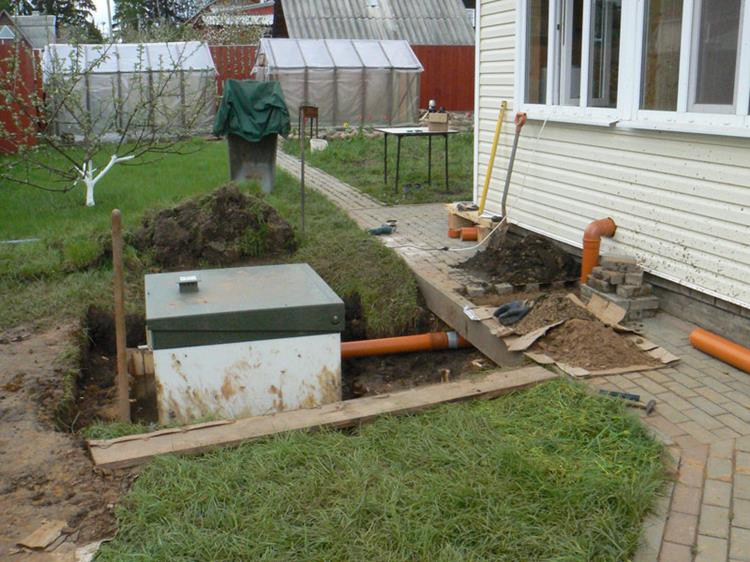
Such a structure, installed according to the above rules, is possible, but it will be advisable only if the owners of the house rarely live in the house. With a permanent presence, other options are usually chosen.
Purifying septic tanks
This type of device is the most common. It consists of two or three chambers where the liquid is purified and then released into the soil for further purification. The septic tank is able to clean up to sixty percent. Therefore, it is impossible to use such water neither for technical needs, nor even for drinking.
Recommended Reading: An Overview of Septic Tank Types
Usually water goes to areas specially allocated for this: filtration fields. You can equip them with any type of soil. But sandy and sandy loam types are most suitable for them. In other cases, significant additional costs will be required. Therefore, they are mostly abandoned in favor of another type of septic tank.
If you buy ready-made devices manufactured at the factory, then they are completely sealed and very durable structures. And if the installation is carried out correctly, it will protect the environment and will not harm human health. But, of course, you can not ignore the safety rules, they should be observed in any case.
Local cleaning stations
Local cleaning stations are the most modern devices that provide the best cleaning, which comes in percentage terms up to ninety-eight. They provide a variety of cleaning methods. This is also a sump, where solid waste settles to the bottom, and the lungs float to the surface. It is also a biological natural purification with the help of special microorganisms: aerobic and anaerobic bacteria, which decompose waste and produce further work.
Almost all VOCs are volatile, and for their operation an uninterrupted supply of electricity must be provided. Often, autonomous stations are installed for this. Naturally, such designs are the most expensive. Yes, and they will be required only if people permanently live in the house. In other cases, it is better to use other types of septic tanks.
VOC is by far the most reliable option for both cleaning and overall system performance. But even in this case, it is necessary to adhere to the current norms and rules and install the structure only with permits from regulatory authorities.
If this rule is not observed, then SES employees have the right to fine the violator and even demand the dismantling of the structure.
https://youtube.com/watch?v=SorAAKhicso
Thus, having decided to build a septic tank on your site, you need to carefully examine the available documents. Only then can you be sure that the project in the SES will be approved, the system will work perfectly, and conflicts with neighbors on this matter will be excluded.
The location of the septic tank on the site
When planning a place for installing a cleaning device, you need to follow the rules, this is the only way you can be sure that there will be no problems in the future. After all, even having received permission from the relevant authorities, you cannot do as you like, it is possible that in the future the work carried out will be checked for compliance with the project.
Video: Sanitary standards for the construction of wells and septic tanks
Regulations
When installing a septic tank, you will have to adhere to the rules and regulations that are regulated by the following documents:
- The fundamental document, which must be guided in the first place -, it regulates the process of building an external sewerage network and structures;
- If a well or a well is used as a water supply, the requirements prescribed in - external networks and water supply and sewerage facilities and - internal water supply and sewerage of buildings are additionally taken into account;
- – describes the requirements for protective measures aimed at maintaining the purity of surface waters;
- - regulates the norms for the creation of sanitary protection zones near environmentally hazardous objects.
Distance to a well
The most stringent requirements are prescribed for placing a septic tank near water intake points. After all, it is no secret that the ingress of sewage into groundwater can lead to contamination of a large number of sources and cause poisoning in people.
And even taking into account the fact that today most factory installations are hermetically sealed and made from heavy-duty materials, no one is immune from an accident. That is why the distance from the septic tank to the source of drinking water (well, well, etc.) should be as large as possible.
A properly located septic tank should be located at a distance of 20 meters or more from a well or well. In addition, the water intake point must be located above it in the direction of groundwater flow. However, if the site is dominated by such a type of soil as: sandy, sandy or loamy, then the minimum allowable distance increases to 50 meters.
Distance to water supply
The regulations also spell out the rules for the location of the septic tank near the pipes of the centralized water supply. It says that the sump should be no closer than 10 meters from the water supply. This will protect the water supply from contamination in the event of an accident.
Distance to home
According to the rules, the distance from the house to the treatment plant should be at least 5 meters. This requirement must first of all be observed for wastewater treatment systems (infiltrators, drainage ditches, filtration fields, etc.). Local treatment plants, such as for example, can be installed closer.
It is also not desirable to locate sedimentation tanks more than 5 meters, since the longer the length of the pipeline, the higher the risk of its depressurization. Therefore, the installation of septic tanks more than 20 meters from the foundation of the house is not recommended.
Distance to neighboring plot, fence
Of course, you want to place the septic tank aside and away from your home, but you should not ignore the interests of your neighbors. Therefore, when drawing up a project, the following rules should be considered:
- from the fence of the neighboring area to the septic tank must be at least 2 m;
- to the road with busy traffic - 5 meters.
Distance to garden
Plants can die from too much moisture. If there is a treatment plant near the garden, then trees and shrubs can get sick and die from excessive moisture. Therefore, the location of the septic tank, and especially the systems of soil post-treatment of wastewater, is not desirable closer than 5 meters from the trees.
Other requirements
When choosing a place for the installation of a septic tank, factors such as:
- installation is recommended to be done in places with soft soil, this greatly facilitates earthworks;
- from the foundation of outbuildings to the septic tank must be at least 3 m;
- SNiP also regulates the regular cleaning of sedimentation chambers, therefore, treatment facilities must have free access for a sewage truck.
Where to place a septic tank on the site, given the norms and distances
Today, equipping a sewer system on your own site is a simple matter. You can build a structure yourself, or seek help from specialized firms. In any case, there is always a choice. Ordinary cesspools have long been a relic of the past. They were replaced by high-quality, solid systems that rarely even require calling a sewage truck to pump out the contents.
And there are systems at all that work autonomously and without pumping. It all depends on your financial capabilities. Therefore, no matter which septic tank you choose for your country house, the main question is where to place the septic tank on the site.
And here it is important to understand that strict rules and norms have been developed here, to adhere to which the task of the owner of the site
Installation guidelines
The septic tank is built according to sanitary standards. It is they who regulate the location of the water pipes. So, according to the regulatory requirements, the gap between them and the sewage system should be more than 10 m. Moreover, it is usually located lower than the well, so that in the event of a breakthrough, the effluent does not enter the water.
Between the treatment system and the house, the gap is also established in accordance with the regulations for the location of the septic tank at the SNiP site. It must be more than 5 m from the foundation.Then, when drains flow out of the septic tank, they will not wash the walls of the building, and the smell will not bother the residents.
We watch the video, the rule for the location of equipment:
https://youtube.com/watch?v=vjnIeOJp09Y
However, the distance from the house to the treatment system should not be very large. This is due to the difficulty of ensuring the normal operation of a very long sewer pipeline. After all, blockages can occur in it, which will be quite difficult to remove with a large length. If you still have to design such a system, then for every 15 m you need to install 1 revision well.
The regulations also regulate the following rules for installing a septic tank:
- The distance from your treatment system to the road is at least 5 m;
- The fence that is installed between you and the neighbors, and the septic tank is allowed to leave 2 m.
In addition to the above rules, there are other regulatory locations of the septic tank on the site. So you need:
- Plan installation on soft ground - this will facilitate the process of preparing the pit;
- Provide convenient access to the well of the treatment system, as it will have to be cleaned of solid residues.
As you can see, the requirements for installing septic tanks in a summer cottage are quite simple and everyone should follow them. This will not only help to avoid accidents and environmental pollution, but also various diseases that can result from the ingress of sewage into drinking water.
Installation expert advice
What should you pay attention to when arranging a treatment system? The main thing with which the installation work begins is the preparation of the pit and trenches for pipes. Where to place the septic tank on the area of the site? Firstly, it is mounted below the freezing level, only then the system will be able to work year-round.
If it is impossible to do this for some reason, then you will have to insulate the pipes with one of the heat-insulating materials or install a heating cable.
If the pit is dug in clay or loam, then its bottom should have a concrete pad to which the storage tank is attached. This is necessary in order to avoid pushing out the septic tank when it is completely cleaned.
Filtration fields or a well must be equipped. But if groundwater is high, then it is better to choose the latter option. The water level in the well is easier to control, and water can be pumped out of it if necessary.
Of course, it is allowed to install a septic tank with any soil, but it is better if it is dry and softer samples. This is due to the work on preparing the pit for equipment. In heavy soil, digging is much more difficult.
Watch the video, the nuances of installation:
https://youtube.com/watch?v=VgLADEPrtu4
Since the treatment systems are located underground, it is necessary to organize air exchange inside the tank. Microorganisms need oxygen for normal development and vital activity. So this point should also be taken into account when performing installation work.
In our article, we examined all the basic requirements for the location of a septic tank in a summer cottage. Only their exact observance will allow to achieve comfortable living conditions outside the city.
After all, modern drains are saturated with various chemicals that have a detrimental effect on nature, which means they must be airtight. In addition, the efficiency and safety of its operation depends on the correct location of the septic tank on the site in accordance with existing standards. The more accurately all requirements are met, the less problems you will have with the maintenance of the treatment system.
Many of us remember the times when the outdoor toilet and outdoor shower were the pinnacle of landscaping a suburban area. Today, such elements are still found in dachas, but the requirements for the level of comfort have long grown, and even in nature, a modern person does not want to deprive himself of the benefits of civilization.So humanity came up with the idea of installing septic tanks, which made it possible to equip the house with the usual shower and toilet. Septic tanks are certainly convenient and practical, but certain risks are associated with them. To reduce them to a minimum, you need to know all the nuances of the correct location of the septic tank on the site. We study the regulatory framework and expert advice.
